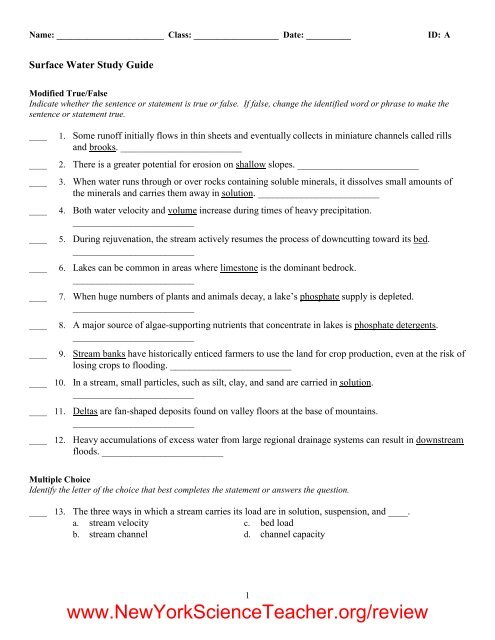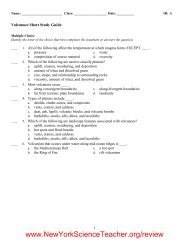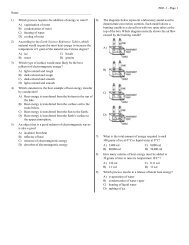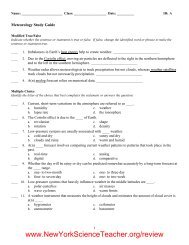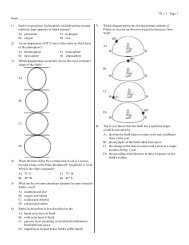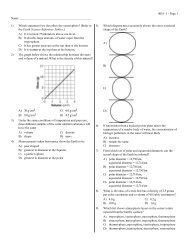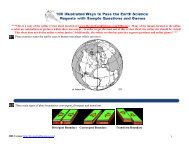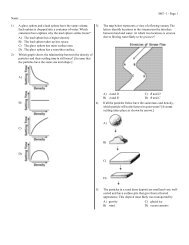pdf - Earth Science Regents Review
pdf - Earth Science Regents Review
pdf - Earth Science Regents Review
You also want an ePaper? Increase the reach of your titles
YUMPU automatically turns print PDFs into web optimized ePapers that Google loves.
Name: ________________________ID: A40. Identify the two stream formations shown below. Compare how each is formed.41. Describe three processes of lake formation.42. Explain how people have contributed to the destruction of wetlands.43. Explain how floodplains develop such highly fertile soils.44. Compare downstream and upstream flooding.45. What factors increase or decrease the amount of runoff in an area?46. In the diagram below, a section of a meandering stream is shown. What occurs at the areas labeled Aand B?47. Describe what causes a stream to stop downcutting its bed and what causes it to start again.48. Compare the velocity of water, the erosion, and the deposition along the inside and outside of ameander curve.49. Describe three ways a natural lake can form.4www.NewYork<strong>Science</strong>Teacher.org/review
Name: ________________________ID: A50. How does an increase in a stream’s velocity affect its discharge and carrying capacity?51. How do vegetation and slope affect runoff?The graph shows the discharge of a river that flows through two cities, Frankston and Wet Gulch. Ateither city, the river’s banks cannot handle a discharge of 3.5 million cubic meters per second ormore. At that point, the river reaches its flood stage. Study the graph and answer the questions.52. During how many days in March did the river at Wet Gulch and Frankston overflow its banks?53. Wet Gulch is downstream from Frankston. How might this account for the difference in dischargebetween the two towns after March 10?54. Both cities were founded as farming communities during the 1800s on the floodplain. Describe thephysical features of a floodplain, and hypothesize as to why people wanted to live on them.5www.NewYork<strong>Science</strong>Teacher.org/review
Name: ________________________ID: AProblemThe table lists water quality measurements that were taken over a 40-year period at Lake Smith.Measurements included dissolved oxygen, pH, phosphate, nitrogen, the number of largemouth bass,and mosses and grasses. Dissolved oxygen is the measure of the amount of oxygen available tolife-forms in the water. Largemouth bass is a common variety of fish found in healthy lakes. Mossesand grasses start to appear as the pH of the water becomes more acidic.Dissolved oxygen(parts per million,Water Quality at Lake Smith1950 1955 1960 1965 1970 1975 1980 1985 1990or ppm) 20 19 18 18 16 17 15 11 9pH 7.6 7.2 7.1 7.0 6.8 6.8 6.5 6.1 5.8Phosphate (ppm) 0.0 0.10 0.20 0.25 0.28 0.28 0.45 0.55 0.55Nitrogen (ppm) 0.05 0.18 0.19 0.25 0.28 0.28 0.35 0.40 0.45Largemouth bass 450 455 448 338 235 220 155 125 50Mosses and grasses 0 0 2 5 15 18 29 35 5555. What is eutrophication? Did it occur at Lake Smith? Explain your answer.56. After 1950, farmers in the Lake Smith area increased their use of fertilizers. Does the data supportthis statement? Explain your answer.57. How do changes in phosphate and dissolved oxygen content over time compare? Explain thechanges that took place.58. What do you predict will happen to the lake in the next 40 years?59. The table shows that the number of largemouth bass decreased as the number of mosses and grassesincreased. From this data, can you conclude that the increase of mosses and grasses caused thelargemouth bass population to decline? Explain your answer.6www.NewYork<strong>Science</strong>Teacher.org/review
ID: ASurface Water Study GuideAnswer SectionMODIFIED TRUE/FALSE1. F, gullies2. F, steep3. T4. T5. F, base level6. T7. F, oxygen8. T9. F, Floodplains10. F, suspension11. F, Alluvial fans12. TMULTIPLE CHOICE13. C14. A15. C16. D17. A18. B19. A20. C21. B22. C23. DCOMPLETION24. runoff25. watershed26. divide27. solution28. suspension29. bed load30. Discharge31. stream channel1www.NewYork<strong>Science</strong>Teacher.org/review
ID: AMATCHING32. C33. E34. F35. A36. B37. G38. DSHORT ANSWER39. Both materials are part of the stream’s load. Materials carried in solution are dissolved in the water.Materials carried in suspension, which vary in amount according to the stream’s velocity, have alarger particle size like sand and silt.40. The example on the left is an alluvial fan. The example on the right is a delta. Alluvial fans aresloping depositional features formed at the bases of slopes and composed mostly of sand and gravel.Deltas are triangular deposits that form where a stream enters a large, quiet body of water.41. Answers may vary. Lakes can form from cutoff meanders that isolate channels of water, other lakesform when streams are blocked off by landslides. Some lakes are remnants of former ocean waters.Lakes can also form from glacial origin.42. Many wetlands have been filled in to create more land for building and for agriculture.43. Each time a flood occurs, the floodwater carries along with it a great amount of sediment erodedfrom <strong>Earth</strong>’s surface and the sides of stream channels. After each subsequent flood, more sediment isdeposited and the soil becomes more fertile.44. Downstream floods occur during or after long-lasting or intense storms. The volume of waterinvolved in a downstream flood is high. Upstream floods are caused by sudden rainstorms that droplarge amounts of rain within a short period of time. They also flood a smaller area.45. Saturated or frozen ground and soil and rocks with few spaces between the particles increase runoffbecause the ground cannot absorb the water. Soil and rocks with large spaces between the particlesand areas with vegetation decrease runoff because more water is absorbed into the ground.46. Area A indicates where deposition is dominant. Area B indicates where erosion is dominant.47. During the process of stream formation, downcutting of the stream bed is a major erosional processuntil the stream reaches its base level and downcutting stops. If the land over which the stream isflowing uplifts or the base level drops, the process of downcutting resumes.48. The velocity of water is greater along the outside of a meander curve, where erosion takes place. Thewater moves slower along the inside of the curve, which results in deposition.49. Possible responses: Oxbow lakes form when streams cut off meanders and leave isolated channels ofwater. Lakes can form when stream flow becomes blocked by sediment from landslides. Some formas remnants of former ocean water that have receded to lower-lying areas. Others form becauseglacial moraines dammed water in ice-gouged basins, or when blocks of ice melt on outwash plains.50. As a stream’s velocity increases, its discharge increases. As its discharge increases, its carryingcapacity also increases.2www.NewYork<strong>Science</strong>Teacher.org/review
ID: A51. Dense vegetation allows more water to enter the ground, thus reducing runoff. The steeper the slope,the faster water flows, and the less water that seeps into the ground, thus increasing runoff.52. Wet Gulch, 3; Frankston, 253. Additional tributaries and runoff likely flow into the river downstream from Frankston, resulting in agreater flood discharge at Wet Gulch.54. A floodplain is the broad, flat area that extends out from a stream’s bank. Since it is covered byexcess water during floods, and floodwater carries a great amount of sediment, floodplains areusually covered with highly fertile soil. People probably wanted to live on floodplains because theycould farm the fertile soil with great success.PROBLEM55. Eutrophication is the filling in of a lake due to excessive organic growth. This excessive growth thendies and decays, which depletes the available oxygen, leaving less for the other life-forms. Animals,such as largemouth bass, cannot survive in water when the dissolved oxygen falls below a certainlevel. And since the data show a decrease in largemouth bass, eutrophication at Lake Smith isindicated. As eutrophication continues and the lake fills in, the oxygen content decreases and theacidity increases, which the data suggest took place at Lake Smith. The data also show an increase inmosses and grasses, which thrive when eutrophication fills in a lake and a wetland forms.56. Possible response: Yes; the phosphate content in the lake water increased after 1950. Agriculturalfertilizers contain phosphates, which may have been picked up by runoff and carried into the lakeafter 1950, thus accounting for the increase in phosphate content.57. As the phosphate content increased, the amount of dissolved oxygen decreased. Lake organisms likealgae most likely thrived on the increased phosphate, then grew rapidly, died, and decayed. Theresulting decaying process depleted the water’s oxygen and further increased the phosphate content.58. Possible response: The amounts of phosphate and nitrogen will continue to increase, the pH willdrop, the dissolved oxygen will become less, bass will die out, and the mosses and grasses willthrive. The lake will start to fill in.59. No, the data do not prove a causal relationship between the increase in the number of mosses andgrasses and the decline in largemouth bass population. For example, largemouth bass could benegatively affected by the other variables in the chart, such as the decrease in dissolved oxygen, thedecreasing pH, and the increasing phosphate level. It is theoretically possible that the increase invegetation has no impact, a negative impact, or a positive impact on the bass population. However,without scientific testing, it is impossible to conclude one way or another.3www.NewYork<strong>Science</strong>Teacher.org/review


